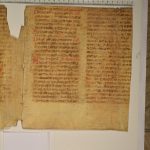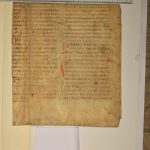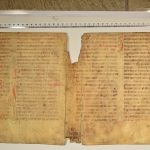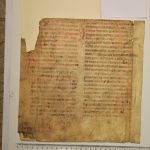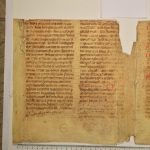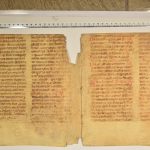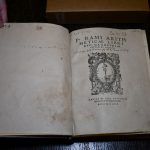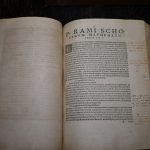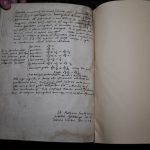The book was restored in 2005 according to the University Library’s documentation, it got its current brown leather binding then. The codex leaf once serving as the cover was no longer on the book at the time of restoration, it was removed much earlier and was considered lost. The former host volume of the separately stored fragment was identified in 2021 by the ‘Momentum’ Digital Music Fragmentology Research Group.
The host volume consists of two mathematical-geometrical compendia of the French humanist, theologian and mathematician, Petrus Ramus (1515—1572) printed in Basel in 1569. The richly illustrated works were used as textbooks from the end of the 16th century and were quite popular at 17th-century protestant universities. This is attested by the numerous marginal inscriptions and commentaries of the Scholarum mathematicarum’s discussed volume, which were supposedly taken by the book’s first user. This user is most likely identical to Johannes Praetorius Joachimicus who filled with his handwritten notes not only the margins, but the last page of the volume, where he also named himself at the bottom of the page: Joh. Praetorius Joachimus scribebat Witebergae die VI Mensis viii.bris An. 1574. Johannes Praetorius (1537—1616) was indeed a professor of mathematics at the Wittenberg University from 1571 to 1576, then he left for teaching at the university in Altdorf near Nürnberg founded in 1575. He was praised by his contemporaries, as he not only was concerned with mathematics, but studied astronomy and chronology, and also experimented with the construction of geometric instruments (comp. Artikel „Praetorius, Johannes“ von Siegmund Günther in: Allgemeine Deutsche Biographie, herausgegeben von der Historischen Kommission bei der Bayerischen Akademie der Wissenschaften, Band 26 (1888), S. 519–520, Digitale Volltext-Ausgabe in Wikisource, URL: https://de.wikisource.org/w/index.php?title=ADB:Praetorius,_Johannes_(Mathematiker)&oldid=-). Some claim that he also designed the plane table (Mensula Praetoriana) for creating topographical measurements. Judged by the number of notes, Praetorius should have known the work of Ramus profusely, which knowledge he must have utilized not only during his years as a university professor but also later, for his scientific work.
We do not know, how long the Ramus-volumes were in the possession of Praetorius. Based on the codicological data we cannot even be certain whether both of the volumes were his, or only one of them, since he has only written his name and taken notes in the Scolarum mathematicarum. And if both of them belonged to Praetorius, was he who bound the volumes? Was the cover made from a codex leaf added to them at this time? And finally: did he bring his book/books from Wittenberg to his new workplace in Altdorf or did he leave them in Wittenberg?
We only know that 64 years after the colophon’s inscription the book got to the Jesuit college of Nagyszombat (Trnava in present-day Slovakia). The host volume was registered in the catalogue of the college library in 1638 with the shelf-mark M 148, according to the note on the first volume’s title page.
The answer to the questions may lie in the codex leaf used to bind the colligatum. The incomplete parchment bifolium is a fragment of a 14th century notated missal. Its liturgical content does not provide a standing-ground to the origins of the mother codex, since its preserved chants and mass texts for the Holy Week and for the week of Pentecost are following a uniform order throughout Europe. However, close relatives of its musical notation can be found in notated liturgical sources of the Saxon centres of German-speaking areas East of the Rhine (comp. Leipzig, Universitätsbibliothek, MS Thomas 391: https://digital.ub.uni-leipzig.de/mirador/index.php). Thus it is possible the binding happened at the book’s first place of use at the end of the 16th century, in the scope of the Wittenberg university. The local bookbinder must have reused a leaf of a missal belonging to a church in this area to bind the new book. The indirect data thus hints that the two Ramus volumes were bound by Johannes Praetorius during his time at the Wittenberg university.
Zsuzsa Czagány


